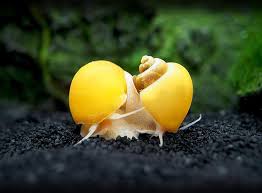1
/
of
1
Midwest Aquarium and Pond Supplier LLC
(26) Yellow Apple Snails
(26) Yellow Apple Snails
Regular price
$4.00 USD
Regular price
Sale price
$4.00 USD
Shipping calculated at checkout.
Quantity
Couldn't load pickup availability
"yellow apple snail" can refer to two very different species with potentially significant consequences for the environment. It is crucial to distinguish between them: the non-invasive yellow mystery snail (a color variant of Pomacea diffusa or bridgesii) and the highly invasive golden or channeled apple snail (Pomacea canaliculata).
The non-invasive yellow mystery snail
This is the species most often sold in pet stores under various names, including "golden mystery snail".
- Scientific name: Pomacea diffusa or Pomacea bridgesii.
- Appearance: They have a smooth, globular yellow shell with a low, less pronounced spire. Their bodies can range from yellow to orange.
- Behavior: They are typically safe for planted aquariums, as they prefer to eat algae, biofilm, and decaying plant matter rather than healthy plants.
- Breeding: They lay clusters of eggs above the waterline, which are easy to spot and remove if you want to prevent breeding.
- Origin: Native to South America, they were introduced to the aquarium trade as a manageable, peaceful snail species.
The highly invasive golden/channeled apple snail
This species poses a significant threat to ecosystems and agriculture and is illegal to possess in many places.
- Scientific name: Pomacea canaliculata.
- Appearance: This species is typically larger than the mystery snail and has a deep indentation or "channel" between the segments of its shell's spiral.
- Behavior: It is a voracious herbivore that will devour all kinds of aquatic plants, including valuable crops like rice and taro.
- Eggs: The most identifiable trait is their signature bright, bubblegum-pink egg clutches laid on surfaces just above the water.
- Origin and impact: Also native to South America, it was introduced to parts of Asia and Hawaii as a food source but quickly escaped and became a major invasive pest. It is considered one of the "world's worst invasive alien species" by the IUCN
Share
No reviews

